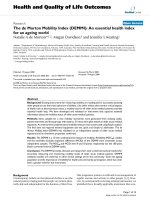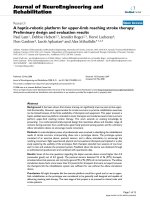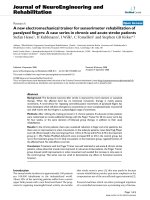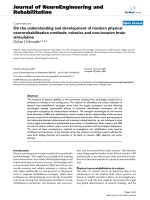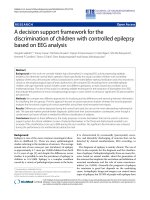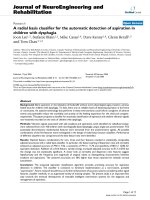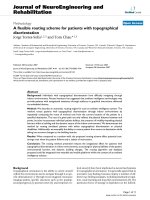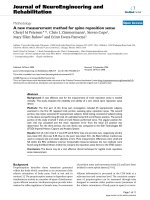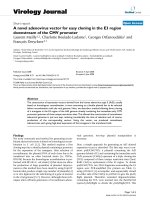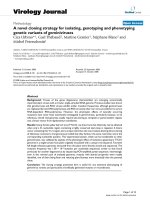báo cáo hóa học: " A pilot study evaluating use of a computer-assisted neurorehabilitation platform for upper-extremity stroke assessment" pptx
Bạn đang xem bản rút gọn của tài liệu. Xem và tải ngay bản đầy đủ của tài liệu tại đây (489.73 KB, 15 trang )
BioMed Central
Page 1 of 15
(page number not for citation purposes)
Journal of NeuroEngineering and
Rehabilitation
Open Access
Research
A pilot study evaluating use of a computer-assisted
neurorehabilitation platform for upper-extremity stroke
assessment
Xin Feng*
1,2
and Jack M Winters
1
Address:
1
Marquette University, Dept of Biomedical Engineering, Olin Engineering Center, Milwaukee, Wisconsin 53233, USA and
2
Lexmark
International, 740 West New Circle Road, Lexington, Kentucky 40550, USA
Email: Xin Feng* - ; Jack M Winters -
* Corresponding author
Abstract
Background: There is a need to develop cost-effective, sensitive stroke assessment instruments.
One approach is examining kinematic measures derived from goal-directed tasks, which can
potentially be sensitive to the subtle changes in the stroke rehabilitation process. This paper
presents the findings from a pilot study that uses a computer-assisted neurorehabilitation platform,
interfaced with a conventional force-reflecting joystick, to examine the assessment capability of the
system by various types of goal-directed tasks.
Methods: Both stroke subjects with hemiparesis and able-bodied subjects used the force-
reflecting joystick to complete a suite of goal-directed tasks under various task settings. Kinematic
metrics, developed for specific types of goal-directed tasks, were used to assess various aspects of
upper-extremity motor performance across subjects.
Results: A number of metrics based on kinematic performance were able to differentiate subjects
with different impairment levels, with metrics associated with accuracy, steadiness and speed
consistency showing the best capability. Significant differences were also shown on these metrics
between various force field settings.
Conclusion: The results support the potential of using UniTherapy software with a conventional
joystick system as an upper-extremity assessment instrument. We demonstrated the ability of
using various types of goal-directed tasks to distinguish between subjects with different impairment
levels. In addition, we were able to show that different force fields have a significant effect on the
performance across subjects with different impairment levels in the trajectory tracking task. These
results provide motivation for studies with a larger sample size that can more completely span the
impairment space, and can use insights presented here to refine considerations of various task
settings so as to generalize and extend our conclusions.
Background
In the United States, stroke is the leading cause of disabil-
ity and affects about 5.6 million individuals today, result-
ing in an estimated direct and indirect cost of $62.7
billion [1]. Up to 85% of the stroke survivors show initial
upper extremity sensorimotor dysfunctions. Between 55%
Published: 28 May 2009
Journal of NeuroEngineering and Rehabilitation 2009, 6:15 doi:10.1186/1743-0003-6-15
Received: 12 November 2007
Accepted: 28 May 2009
This article is available from: />© 2009 Feng and Winters; licensee BioMed Central Ltd.
This is an Open Access article distributed under the terms of the Creative Commons Attribution License ( />),
which permits unrestricted use, distribution, and reproduction in any medium, provided the original work is properly cited.
Journal of NeuroEngineering and Rehabilitation 2009, 6:15 />Page 2 of 15
(page number not for citation purposes)
and 75% of patients continue to experience upper extrem-
ity functional limitations after 6 months of the stroke,
which are associated with diminished health-related qual-
ity of life [2].
Quantification of upper-extremity movement features in
patients with stroke is a critical component for supporting
the optimization of intervention plans [3], so as for
understanding the underlying mechanism of the upper
extremity impairments induced by stroke. In today's reha-
bilitation practice, stroke assessment in clinical settings
generally involves use of observer-based, ordinal scale
instruments, such as the Functional Independence Meas-
ure (FIM) [4], Fugl-Meyer Assessment [5], Wolf Motor
Function Test [6], Chedoke-McMaster Stroke Assessment
[7] and so on. Although these ordinal instruments are
well established and have proven to be reliable and sensi-
tive for measuring gross changes in functional perform-
ance, they can be problematic because of poor consistency
in the differences between scale increments [8]. They also
lack sensitivity to characterize small yet potentially impor-
tant changes during the intervention process [9,10]. The
subjectivity of these tests is well recognized [11]. Further-
more, due to the economic pressure on the healthcare sys-
tem, patients with stroke, particularly the outpatient
population, have a limited access to rehabilitation
resources [12]. Due to these reasons, there is a need to
develop cost-effective, semi-autonomous/autonomous,
yet sensitive assessment instruments for patients with
stroke at home, which is characterized by low cost and
under-supervision from rehabilitation practitioners.
Measures derived from kinematic trajectories associated
with goal-directed tasks are continuous metrics which can
potentially be sensitive to the subtle changes in the inter-
vention process. They can also be more objective and
repeatable across subjects than clinical ordinal scales [10].
The results from previous studies which examined the
assessment capability of kinematic measures for stroke-
induced impairments are summarized below.
Reaching to a target object is one fundamental compo-
nent in the activities of daily livings (ADLs) (e.g. eating,
drinking, grooming) which involve arm movements.
Many studies have examined point-to-point reaching in
subjects with stroke-induced impairments and found that
their movements are characterized by slowness [13,14],
spatial and temporal segmentation [15], abnormal pat-
terns of muscle activation [13,16], decreased movement
range [17] and so on. Selected kinematic measures devel-
oped by these studies, such as movement time, elbow
extension, shoulder flexion, displacement of the trunk
and the active ranges of motion (ROM), have shown a sig-
nificant correlation with the clinical motor function scales
(e.g. upper extremity motor control portion of Fugl-Meyer
assessment, Chedoke-McMaster Stroke Assessment).
Some of these kinematic measures, such as movement
time, significantly correlated with clinical spasticity scales
(e.g. Ashworth scale [18], modified Ashworth scale [19]).
Trajectory-tracking tasks require common components
involved in both perception-action coupling and func-
tional motor tasks: perception of environmental con-
straints, motor planning and execution, and corrective
monitoring of performance including explicit feedback
[10]). Several studies have already evaluated the assess-
ment capability of trajectory tracking task with subjects
with stroke-induced impairments. It has been demon-
strated that the motor functional level of subjects and
their performance in trajectory-tracking tasks are closely
related [20,21]. Furthermore, certain kinematic metrics
(e.g. root mean squared error (RMSE)) derived from tra-
jectory tracking tasks have been demonstrated as a relia-
ble, sensitive assessment tool of the upper-extremity
motor function in subjects with stroke-induced hemipare-
sis [10].
Many daily activities, such as holding a cup of tea, driving
a car, and replacing light bulbs, require one to cope with
some level of instability in the manipulated object. It is
important to evaluate the performance of subjects with
stroke in a goal-directed task in an unpredictable mechan-
ical environment to better understand the strategy that
they used to cope with instability [22,23]. Recent experi-
mental evidence also suggests that patients with stroke-
induced impairments may likely benefit from training of
the paretic limb in unpredictable mechanical environ-
ments [24-27], and the improvement can potentially be
transferred to ADLs.
These studies laid down a rationale stage for developing
kinematic measures derived from goal-directed tasks as
upper-extremity assessment instruments, but also leave
several fundamental questions unanswered. First, to date
the majority of biomechanical upper-extremity evalua-
tions involve reaching and trajectory tracking performed
at a limited number of task settings, most commonly at
one speed in the horizontal plane with the arm supported
[28]. In order to personalize the intervention plan for a
given client with stroke-induced impairments with the
goal of optimizing the functional outcome, we need to
better understand the performance of subjects with stroke
under various goal-directed tasks. It is necessary to
develop a suite of performance metrics to characterize var-
ious movement features in the goal-directed tasks, such as
slowness, segmentation, and a decreased range of motion,
movement speed, and coordination and so on.
Second, while interventions that are based on robotic
therapy have proven to be effective for sub-acute and
Journal of NeuroEngineering and Rehabilitation 2009, 6:15 />Page 3 of 15
(page number not for citation purposes)
chronic stroke populations [29-31], the advantages of
mechanical guidance by the robotic device over other
stroke therapy technique still remain elusive [32]. It is
worthwhile to examine the performance of subjects with
stroke under various mechanical environments in goal-
directed tasks, so that we can better understand the role of
force on the performance of subjects with stroke-induced
impairments and potentially optimize the mechanical
environment in the robotic-assisted therapy plan for a
given client.
Third but probably more important for outpatient reha-
bilitation, most of these studies summarized here are
using either large robotic systems or three dimensional
(3D) marker-based motion analysis systems as their
research platform. While these tools provide abundant
sensor-based performance data, high costs and mechani-
cal sophistication appear to limit the likelihood of their
large-scale implementation, particularly for the home set-
ting, which is more convenient and sometimes the only
option for many persons who could benefit from thera-
peutic interventions.
In summary, there is a need to develop alternative, cost-
effective yet still sensitive tools for upper-extremity stroke
assessment, particularly for outpatient rehabilitation. This
paper presents the findings from a pilot study using Uni-
Therapy software [33,34] interfaced with a conventional
force-reflecting joystick. This software also has been used
by adapted larger joysticks called TheraJoy [35-37] and for
driving wheels called TheraDrive [38], but with different
aims. Here the focus is on evaluating a suite of perform-
ance metrics that were derived from goal-directed tasks
supported by UniTherapy technology. The sensitivity of
these metrics as home-based assessment instruments were
evaluated within the context of two hypotheses: hypothe-
sis 1) Impairment level of human subjects influences per-
formance on various goal-directed tasks using a
conventional force-reflecting joystick, and hypothesis 2)
Force field settings in continuous tracking tasks influence
the performance of human subjects across impairment
levels. The focus here is whether our performance metrics,
developed using a low-cost computer-assisted platform,
have as enough usability and sensitivity for use as assess-
ment tools for a home rehabilitation as a component
within a larger-scale biomechatronic system. A key ques-
tion relates to which of the many viable metrics are most
effective in terms of sensitivity, here addressed within the
context of these hypotheses, and this is the focus of the
discussion.
Methods
In this section, we describe the experiment setup and pro-
tocols used in this study, particularly focusing on the
selected goal-directed tasks for evaluating the potential of
UniTherapy software interfaced with the conventional
force-reflecting joystick for upper-extremity stroke assess-
ment.
Experiment platform
We utilize UniTherapy software interfaced with a conven-
tional force-reflecting joystick (Microsoft Sidewinder)
along with TheraJoy (adapted joystick) [35-37] for the
data collection component of in this study. UniTherapy
software implements three toolboxes consisting of cus-
tomizable goal-directed tasks to quantify the various
aspects of upper-extremity movement features [33]. These
toolboxes are outlined below:
• The Range of Capacity (ROC) toolbox can be used to
assess the user's initial and final capability ROM when
using an input device and optionally used to map
between the input device workspace range and the user's
capability range by a two dimensional (2D) transforma-
tion algorithm [33].
• The Tracking toolbox implements discrete tracking and
continuous tracking. Discrete tracking (target acquisition)
requires the subjects to move a cursor into a target win-
dow with accuracy; once the subjects get into the target
window, they receive a positive visual feedback and
optionally a sound cue, and they are required to stay as
stable as possible for a threshold of success time (defined
as dwelling time); after successful completion of dwelling
time, the target jumps to the next predefined position.
Continuous tracking instructs subjects to follow the con-
tinuously moving target and try to stay within the target
window as much as they can, for which they receive a pos-
itive visual feedback when they stayed within the target
window. The size of the target window and dwelling time
are customizable.
• The users' stable motor performance is also evaluated
using the System Identification toolbox. Predefined force
perturbations are applied to the subject under a certain
instruction (e.g. "hold," "relax"). The force data and
experimenter's instruction are recorded as input while
subject's movement data is recorded as output.
UniTherapy applied none or varying levels of force-feed-
back to physical therapeutic interfaces, depending on the
settings and the task; these were derived from a series of
force effects such as spring, damper, constant and so on in
DirectX. Both sampling of position data and the input of
force were at 33 Hz.
The joystick systems used in this study consisted of the
conventional force-reflecting joysticks (Microsoft
Sidewinder) and the larger "TheraJoy" in horizontal and
vertical settings [35-37], and incorporate a larger range of
Journal of NeuroEngineering and Rehabilitation 2009, 6:15 />Page 4 of 15
(page number not for citation purposes)
motion that can be scaled and modified depending on the
anthropometrics and abilities of the user. Here the focus
is on a detailed analysis of selected data for the conven-
tional joystick, related to the aim of identifying sensitive
assessment metrics; most of the other data was used as
part of the Master's Thesis by Johnson [37].
There are multiple reasons for this focus on the conven-
tional force-reflecting joystick. First, unlike the larger cus-
tom-made TheraJoys, these joysticks are available without
special alteration. Second, it has been shown through
video analysis that significant movement of the torso was
uncommon when using the conventional joystick versus
the TheraJoy devices [37]. Third, EMG analysis has shown
convincingly that the shoulder muscles are quite involved
with the conventional joystick because the high degree of
humeral rotation that accompanies "horizontal" move-
ments and the natural reach involved in "vertical" move-
ments – movement-related EMG activity for the pectoralis
major, anterior deltoid and lattissimus dorsi was consist-
ently higher than for the wrist flexor and extensor groups,
and indeed even the triceps and posterior deltoid were
typically more active than the wrist flexors [37]. Fourth,
the forces applied by the joystick motor to the hand are
much higher for the conventional joystick, with its
smaller lever arm. Fifth, the system bandwidth due to
applied force oscillations is higher with the lower mass of
the Microsoft Sidewinder joystick, about 9 Hz, with there
still being plenty of movement response up to the upper
limit of 16 Hz, and with reliable linearity of the output
torque [38]. Finally, a systematic study of task perform-
ance with the conventional joystick placed at 6 different
locations within the workspace showed only moderate
performance variance within the primary ability space of
the user [37], supporting the decision made for this study
of letting the subject select a location that they found to be
a comfortable range, given their abilities.
Performance metrics
A number of customized and standard performance met-
rics examining accuracy [20,21,13,10,39], smoothness
[15,17], response capability [14,40], movement quick-
ness [13-15], curvature [13,27,40], steadiness,
strength[41], exercise intensity and duration, motivation
[42], and so on have been developed for each toolbox in
UniTherapy [34]. These metrics were implemented to
quantify performance outcomes of goal-directed tasks,
monitor training intensity and evaluate patients' adher-
ence to the protocol [34,38]. Table 1 summarizes selected
performance metrics that are used in the analysis of the
goal-directed tasks presented in this paper.
Subjects
This study was approved by the Institutional Review
Board (IRB) at Marquette University. Subjects with stroke-
induced hemiplegia (n = 9) and able-bodied (Control)
subjects (n = 8) participated in this study and gave
informed consent. The controls were not age-matched,
and consisted of a convenience sample of mostly young
adults. Given that our overriding aim related to assess-
ment metric sensitivity rather than hypothesis testing, the
primary objective for including controls was to establish a
normal baseline for the various performance metrics,
Table 2 summarizes the information of the subjects with
stroke-induced disability, all of who were at least twelve
months post-stroke and had been discharged from all
forms of physical rehabilitation. The upper extremity
motor control portion of the Fugl-Meyer (UE-FM) assess-
ment test was included as a tool to assess level of upper-
extremity motor impairment of subjects with stroke. UE-
FM is used to further partition subjects with stroke into a
low (n = 4, UE-FM (22 to 57)) and high (n = 5, UE-FM (63
to 66)) functional subgroup. Of note is that a UE-FM of 66
is the same score as for an able-bodied normal person,
and yet these individuals clearly viewed themselves as dis-
abled; the lack of sensitivity of metrics such as UE-FM – a
ceiling effect in this case – was a key motivation behind
this study.
Procedures
The experimental protocol consisted of two sessions
focusing first on training the individual on using each
device (conventional joystick (CJS) and TheraJoy in hori-
zontal (HJS) and vertical (VJS) settings), then on collect-
ing performance data for a suite of goal-directed
assessment tasks in the second session. In the first session,
all joysticks were placed in the position of greatest com-
fort for the subject, including altered handle position and
interface to allow for maximum comfort. Subjects first
completed several goal-directed tasks from the Tracking
and System Identification toolbox with the conventional
joystick. A subset of tasks was then repeated with the HJS
and VJS. The medial-lateral and proximal-distal direction
of the joystick movements were mapped to the X and Y
direction on the computer screen. All tasks were repeated
with both arms. On the second day, these goal-directed
tasks were repeated but this time both video and EMG
data were also collected but not presented here.
Tasks
Representative results from three classes of task are pre-
sented here: 1) continuous circle tracking tasks under
three different force settings (e.g. white noise perturba-
tion, no force, spring-assistance), 2) eight-point rectangle
target acquisition, and 3) pseudo-random perturbation
task under "hold" instruction. Both the control and stroke
groups were asked to complete these tasks. For both con-
tinuous tracking and target acquisition tasks, the target
window size were set at 5% of the width of the workspace;
Journal of NeuroEngineering and Rehabilitation 2009, 6:15 />Page 5 of 15
(page number not for citation purposes)
for the target acquisition task, the dwelling time for suc-
cessful completion was set to one second.
Continuous Circle Tracking
Here subjects were asked to follow a continuously moving
target along a circle pattern and to stay within the target
window as much as possible. The circle pattern was
screen-centered with a diameter equalling 90% height of
the workspace. The target smoothly moved with a speed
12 seconds/circle in the counter-clockwise direction. They
completed this tracking task under three conditions:
spring-assistance (eq. 1), white noise perturbation with
bandwidth frequency content up to 16 Hz (eq. 2) and no
force. The force field of spring assistance and white noise
perturbation are generated by:
Spring assistance Subject Target:*( )
,,,
FK
xy xy xy
=−
(1)
Table 1: Summary of the performance metrics for the goal-directed tasks
Goal-directed Tasks Metric Definition Remark
Continuous Tracking Percentage Time in Target (PTT) The percentage of the time the human subject
staying within the target window.
Accuracy and Steadiness
Root Mean Square Error (RMSE) The squared root of the mean-squared distance
from the subject position to the target position.
Accuracy
Deviation The mean of the perpendicular distance from
the subject position to the target line within the
movement time.
Path Deviation
Speed_Mean (SM) The mean of the subject speed during the
continuous tracking task
Speed Consistency
Speed_StdDev (SS) The standard deviation of the subject speed
during the continuous tracking task
Speed Consistency
Discrete Tracking
(Target Acquisition)
Reaction Time The time from the movement of the target to
the first significant movement made by the
subject.
Reaction Quickness
Movement Time The time window from the end of the reaction
time to the time after which the user has stably
reached the target.
Movement Quickness
Deviation The mean of the perpendicular distance from
the subject position to the target path line.
Path Deviation
Movement Speed The mean of subject speed. Movement Quickness
Peak Speed Number The number of local maximum speed within the
movement time window.
Smoothness
Dwelling Percentage Time in Target The percentage of the time that the subject
stayed within the target window during the
Dwelling Time.
Stability
Success Percentage The percentage of the targets that have been
successfully reached by the subject.
Overall Reaching Capability
System Identification Error_Mean The mean of the displacement outside of the
holding area in both x and y direction
Strength (under "hold" instruction)
Error_StdDev. The standard deviation of the displacement
outside of the holding area in both x and y
direction
Journal of NeuroEngineering and Rehabilitation 2009, 6:15 />Page 6 of 15
(page number not for citation purposes)
where F
x, y
represents the force at x and y directions, K rep-
resents the spring coefficient and was set as the highest
stiffness which the conventional joystick can provide,
Random [0,1]
x, y
is a random function on both x and y
direction separately (with values of 0 as no force and ± 1
as maximum force magnitude), Subject
x, y
represents the
subject position, and Target
x, y
represents the target posi-
tion. The spring-assistance force vector was directed to
help pull the subject toward to current target location.
The task was repeated 3 times under each type of force
field, with the sequence of force field being randomly
arranged by the experimental protocol in order to mini-
mize the "learning effect" on the result. Example results
are provided in Fig. 1.
Eight-Point-Rectangle Target Acquisition
Subjects were asked to complete an Eight-Point-Rectangle
target acquisition task, where they moved the conven-
tional joystick to acquire a square box (target window)
with accuracy and at a comfortable speed. As shown in
Fig. 2, the rectangle pattern was screen-centered with 90%
width and height of the workspace. The target moved to
eight locations which appeared in a counter-clockwise
order and were equally distributed on the four lines of rec-
tangle. This rectangle pattern was repeated three times.
The task is space-predictable, as the subject knew the loca-
tion for the next target; the time between target transitions
was not purely predictable, as it depended on the subject's
performance in reaching and staying in the target window.
Pseudo-Random Perturbation under "hold" instruction
As shown in Fig. 3, subjects were asked to complete a
pseudo-random perturbation task generated by the Sys-
tem Identification toolbox, with the conventional force-
reflecting joystick under "hold" instruction, in which they
were asked to stay within the holding area during the per-
turbation as much as possible. The pseudo-random per-
turbation was generated by an algorithm which ensured
that the amplitude of the force has an equal opportunity
to be set among the negative maximum value, 0, and the
positive maximum value, generating frequency content
up to 16 Hz. The task involved application of these
pseudo random perturbations in each of the x and y direc-
tions for three seconds separately. The start time and
sequence of the perturbation appeared unpredictable to
the subjects, and of a magnitude that made it challenging
for the "hold" instruction. The holding area in this task
was thus large, consisting of a screen-centered rectangle
with 40% width and height of the workspace.
Data and statistical analysis
Representative tasks were analyzed across subjects using
the performance metrics defined in Table 1. Mean and
standard deviation values were calculated and presented
for control (n = 8), high function (n = 5), and low func-
tion (n = 4) groups. For the continuous circle tracking
task, a mixed-design repeated measure ANOVA test was
used to test between group (by functional level) and
within group (by force settings) difference. For the eight-
point rectangle target acquisition and pseudo-random
White noise perturbation : [ , ]
,,
F Random
xy xy
= 01
(2)
Table 2: Summary information of the subjects with stroke
Subjects Group Subject ID Age Gender Impaired side UE-FM Sub-group
Stroke-Induced Hemiplegia S1 55 F R 22 Low function
S2 33 M R 24
S3 76 F L 46
S4 57 F L 57
S5 58 F R 63 High function
S6 58 F L 65
S7 58 M R 65
S8 55 F L 66
S9 58 M L 66
Note: F: Female, L: Left, M: Male, R: Right, UE FM: upper-extremity motor control portion of Fugl-Meyer assessment.
Journal of NeuroEngineering and Rehabilitation 2009, 6:15 />Page 7 of 15
(page number not for citation purposes)
Example results of the continuous circle tracking task using a conventional force-reflecting joystickFigure 1
Example results of the continuous circle tracking task using a conventional force-reflecting joystick. The data is
from able-bodied subject 1012. Note: A: spring assistance, B: white noise perturbation force field, blue color: subject position;
red color: target position.
Journal of NeuroEngineering and Rehabilitation 2009, 6:15 />Page 8 of 15
(page number not for citation purposes)
Eight-point-rectangle Tracking Pattern used for a Target Acquisition TaskFigure 2
Eight-point-rectangle Tracking Pattern used for a Target Acquisition Task. A: Eight-Point-Rectangle track pattern
used in the target acquisition task. The rectangle is screen-centered with 90% width and height of the workspace. The num-
bered rectangle represents the sequence of predefined target position, which is equally distributed on four lines of rectangle. B:
Example subject position and target position data for Eight-Point-Rectangle target acquisition task (from subject 1006 in low
functional stroke group). Note: blue color: subject position; red color: target path line.
Journal of NeuroEngineering and Rehabilitation 2009, 6:15 />Page 9 of 15
(page number not for citation purposes)
perturbation tasks, a repeated measure ANOVA test was
used to test between group (by functional level) differ-
ences. The Tukey test was used for post-hoc analysis. A sig-
nificance threshold level of p < 0.05 was used for
interpretation. Statistical analysis was performed on the
data using XLSTAT 2006 (AddinSoft, http://
www.xlstat.com).
Results
Continuous circle tracking under various force field
Table 3 provides the means and of performance metrics
for continuous circle tracking tasks (e.g. Percentage Time
in Target (PTT), Root Mean Square Error (RMSE), Devia-
tion, Speed_Mean (SM), Speed_StdDev (SS)) under con-
ditions of white noise perturbation, no force and spring-
assistance force fields across all subjects. For between
group difference, the results for all of these metrics show
significant differences between low functional stroke
group and controls/high functional stroke group, which
suggests that the performance of able-bodied/high func-
tional stroke subjects in the trajectory tracking tasks tend
to be more accurate (PTT, RMSE), stable (PTT), with less
path deviation (Deviation) and better speed consistency
(SM, SS) than subjects with low functional stroke. There is
also a significant difference with SS metric and a strong
trend in the differences with PTT (p = 0.149) and SM (p =
Example Data from the Pseudo-random Perturbation at X and Y Directions Separately under "Hold" InstructionFigure 3
Example Data from the Pseudo-random Perturbation at X and Y Directions Separately under "Hold" Instruc-
tion. The position data are from A: subject 1011 (able-bodied subject) and B: subject 1005 (subject with low functional stroke).
Note: blue: subject position; red: holding area.
Table 3: The mean and standard deviation of the performance metrics in the continuous circle tracking tasks
By Functional level By force settings
Control High Low Assistance No force Perturbation
PTT 40.87 ± 23.00† 31.80 ± 17.70† 14.30 ± 16.19‡ 50.10 ± 23.94‡ 33.28 ± 12.39‡ 13.04 ± 6.63‡
RMSE 5.02 ± 2.47† 6.25 ± 2.16† 19.29 ± 20.96‡ 6.58 ± 8.71 7.54 ± 2.44 12.99 ± 16.05
Deviation 1.13 ± 1.14† 1.11 ± 0.83† 9.57 ± 15.18‡ 1.94 ± 5.56 2.68 ± 0.78 5.64 ± 11.50
SM 1.93 ± 1.19† 2.39 ± 1.69† 3.23 ± 2.37‡ 1.17 ± 0.08† 1.31 ± 0.24† 4.53 ± 1.09‡
SS 1.37 ± 0.87‡ 1.94 ± 0.99‡ 2.85 ± 1.68‡ 0.89 ± 0.35‡ 1.54 ± 0.75‡ 3.14 ± 1.10‡
The continuous circle tracking tasks are repeated under white noise perturbation, no force and spring assistance force field. The results are
grouped by functional levels and force settings. Note: PTT: percentage time in target, RMSE: root mean square error, SM: Speed_Mean; SS:
Speed_StdDev, †: Differences significant from another group (p < 0.05). ‡: Differences significant from another two groups (p < 0.05).
Journal of NeuroEngineering and Rehabilitation 2009, 6:15 />Page 10 of 15
(page number not for citation purposes)
0.105) metrics between control and high functional
stroke group, which suggest that the performance of able-
bodied subjects in the trajectory tracking task tend to be
more accurate (PTT), stable (PTT) and with better speed
consistency (SM, SS) than high functional stroke subjects.
For within group difference, there are significant differ-
ences with PTT and SS metrics between spring-assistance,
no force and white noise perturbation settings. This sug-
gests that spring-assistance can significantly improve the
performance on accuracy, steadiness and speed consist-
ency in the trajectory tracking across subjects with differ-
ent impairment levels, while perturbation significantly
worsens these aspects of movement performance. There is
also a significant difference with SM metric between per-
turbation and no force/assistance setting, which confirms
that perturbation significantly diminishes the capability
of keeping consistent with the target speed in the trajec-
tory tracking tasks across subjects.
Eight-point rectangle target acquisition
Fig. 4 provides the means and standard deviation of stra-
tegic discrete-task performance metrics [Reaction Time
(RT), Movement Time (MT), Deviation, Movement Speed
(MS), Peak Speed Number (PSN), Dwelling Percentage
Time in Target (DPTT) and Success Percentage (SP)] for
the eight-point rectangle target acquisition task across the
subjects. These metrics are defined in Table 1. The results
on RT, MT, MS, PSN, DPTT and SP metrics show that sig-
nificant differences exist between low functional stroke
group and controls/high functional stroke group, which
suggest that the performance of able-bodied/high func-
tional stroke subjects have higher capabilities in the
aspects of reaction quickness (RT), movement quickness
(MT, MS), smoothness (PSN), steadiness (DPTT) and
The means and standard deviation of the performance metrics in eight-point rectangle target acquisition task across subjectsFigure 4
The means and standard deviation of the performance metrics in eight-point rectangle target acquisition task
across subjects. The results are grouped into control, high functional stroke and low functional stroke groups. Asterisks indi-
cate significant differences between groups at P < 0.05 (Tukey test). Notes: DPTT: dwelling percentage time in target, MS:
movement speed, MT: movement time, PSN: peak speed number, RT: reaction time, SP: success percentage.
Journal of NeuroEngineering and Rehabilitation 2009, 6:15 />Page 11 of 15
(page number not for citation purposes)
overall reaching (SP). There is no significant between-
group difference shown in Deviation metric, which sug-
gest that this metric is not sensitive enough in target acqui-
sition tasks to differentiate the subjects with different
impairment levels.
Pseudo-random perturbation under "hold" instruction
Fig. 5 provides the means and standard deviation of per-
formance metrics for the pseudo-random perturbation
tasks [Error_Mean at x direction (EM_X), Error_StdDev at
x direction (ES_X), Error_Mean at y direction (EM_Y),
Error_StdDev at y direction (ES_Y)], in x and y directions
separately, under "hold" instruction. These metrics are
defined in Table 1. Under the x-direction pseudo-random
perturbation, EM_X and ES_X metrics showed a signifi-
cant difference between low functional stroke group and
controls/high functional stroke group, which suggests that
it is challenging for patients with low functional stroke to
compensate the perturbation from medial-lateral direc-
tion. In general there was more motion and presumably
less impedance in this direction. Under the y-direction
pseudo-random perturbation, there is no significant
between-group difference shown in EM_Y and ES_Y met-
rics. Under x and y direction pseudo-random perturbation
separately, there is no y direction error for control and
high functional stroke group. These data suggest that sub-
jects with different impairment levels, including low func-
tional stroke, are able to compensate for pseudo-random
perturbations in the proximal-distal (or toward-away)
direction much better than in the medial-lateral (or left-
right) direction.
Discussion
This paper evaluates the assessment capabilities of the
UniTherapy software interfaced with the conventional
force-reflecting joystick, using selected goal-directed tasks
which were designed to capture the basic movement com-
ponents (e.g. reaching, tracking, and coping with instabil-
ity) that may relate to ADLs. A suite of kinematic measures
were developed to examine various movement features in
each type of goal-directed tasks. The results support the
potential of using UniTherapy software with joystick sys-
tem as an upper-extremity assessment instrument. We
demonstrated the ability of using various types of goal-
directed tasks to distinguish between subjects on different
impairment levels (hypothesis 1). In addition, we were
able to show that different force fields have a significant
effect on the performance across subjects with different
impairment levels in the trajectory (continuous) tracking
task (hypothesis 2).
For assessment measures associated with the continuous
tracking tasks, for the continuous circle tracking task, we
found that certain measures can differentiate between
control/high functional group and low functional stroke
group: performance of able-bodied/high functional stroke
subjects in the trajectory tracking tasks were significantly
more accurate (Percentage Time in Target (PTT), Root
Mean Square Error (RMSE)), stable (PTT), with less path
deviation (deviation) and better speed consistency
(Speed_Mean (SM), Speed_StdDev (SS)) than subjects
with low functional stroke. This was true even for the rel-
atively small size of the sample population, as reflected in
the levels of statistical significance between groups. One
possible reason for this performance difference was that
subjects with moderate to severe stroke may take more
time for movement planning and for correction based on
their visual feedback. In comparing between control and
high functional stroke group, there is also a significant dif-
ference on SS metric as well as a trend of difference
observed on PTT and SM metrics: able-bodied subjects
can perform more accuracy (PTT), more steadily (PTT)
and with better speed consistency (SM, SS) than subjects
with high functional stroke. The capability to differentiate
between able-bodied subjects and subjects with high
functional stroke as well as between high and low func-
tional stroke subjects by using SS metric and potentially
the PTT and SM metrics suggests that these metrics could
be sensitive to the impairment level of human subjects
across assistance, no force and perturbation force settings
with the trajectory tracking task. The result on the RMSE
metric was consistent with other published data that
RMSE were found to be sensitive the impairment level of
human subjects [20,21,10]. However, as is reflected in the
paragraphs that follow, overall this most convenient met-
ric was not found to be one of the more robust metrics in
terms of sensitivity.
For assessment measures associated with discrete tracking
tasks, for the eight-point rectangle task, the results for
Reaction Time (RT), Movement Time (MT), Movement
Speed (MS), Peak Speed Number (PSN), Dwelling Per-
centage Time in Target (DPTT) and Success Percentage
(SP) metrics show that significant differences exist
between control/high functional stroke group and low
functional stroke group. This suggests that the able-bod-
ied/high functional stroke subjects have higher move-
ment capabilities in reaction quickness (RT), movement
quickness (MT, MS), smoothness (PSN), stability (DPTT)
and overall reaching (SP).
For assessment measures associated with perturbation
with "hold" instruction tasks, under x-direction pseudo-
random perturbation, the EM_X and ES_X metrics
showed significant difference between low functional
stroke group and controls/high functional stroke group,
which suggest that it is challenging for patients with low
functional stroke to compensate for the perturbation from
the medial-lateral direction. This seems likely due to the
directional differences in the spring-like impedance field
Journal of NeuroEngineering and Rehabilitation 2009, 6:15 />Page 12 of 15
(page number not for citation purposes)
The means and standard deviation of the performance metrics in x and y direction pseudo-random perturbation separately, under "hold" instructionFigure 5
The means and standard deviation of the performance metrics in x and y direction pseudo-random perturba-
tion separately, under "hold" instruction. The results are grouped into control, high functional stroke and low functional
stroke groups and normalized to % workspace width. Asterisks indicate significant differences between groups at P < 0.05
(Turkey test). Notes: EM_X: Error_Mean at x direction, EM_Y: Error_Mean at y direction, ES_X: Error_StdDev at y direction,
ES_Y: Error_StdDev at y direction.
Journal of NeuroEngineering and Rehabilitation 2009, 6:15 />Page 13 of 15
(page number not for citation purposes)
within the horizontal arm workspace, with the stiffness
value generally higher in the proximal-distal direction
than the medial-lateral direction as documented by the
previous studies [43-45]. Previous studies have also
shown that shoulder stiffness is direction dependent and
task dependent [46,47]. Under y-direction pseudo-ran-
dom perturbation, there is no significant between-group
difference shown in EM_Y and ES_Y metrics. This suggests
that subjects with different impairment level, including
low functional stroke, either can compensate for the
pseudo-random perturbation from the proximal-distal
direction or there are intrinsic direction-sensitive mechan-
ical impedance reasons that are helpful, or most likely a
combination of both. Of note is that the control and high
functional stroke group can compensate quite well. In
terms of functional assessment strategies, these results
suggest that when using the perturbation task under the
"hold" instruction as a strength assessment test, perturba-
tions in the medial-lateral direction provide a more sensi-
tive task setting (and associated metrics) than
perturbations in the proximal-distal direction, and can
potentially be a challenging task for the stroke subjects
with weak strength.
In summary, despite the relatively small sample size, kin-
ematic metrics developed for various types of goal-
directed tasks in UniTherapy were able to differentiate
subjects with different impairment levels, supporting
hypothesis 1. This is consistent with previous findings by
other research studies [20,21,13,17,10]. Particularly, SS,
and potentially PTT and SM metrics, derived from the
continuous tracking task, showed the best capability for
differentiating between subjects with low function stroke
and high function stroke, as well as between subjects with
high functional stroke and able-bodied subjects.
When we tested three different force setting (e.g. white-
noise perturbation, no force, spring-assistance) across
subjects in a continuous circle tracking task, significant
differences were shown by the PTT and SS metrics
between spring-assistance, no force and white noise per-
turbation settings, thus supporting hypothesis 2. This sug-
gests that spring-assistance can significantly improve the
performance on accuracy (PTT), steadiness (PTT) and
speed consistency (SS) in the trajectory tracking across
subjects with different impairment level, while perturba-
tion significantly worsens these aspects of movement per-
formance. These results also confirm that perturbations
significantly worsen the capability of keeping consistent
(SM) with the target speed in the trajectory tracking tasks
across subjects. Also, these results suggest that PTT
emerges as a potentially sensitive assessment metric for
trajectory tracking tasks across various task settings, since
PTT has the capability to characterize different phases in
the trajectory tracking task, including motor planning,
motor execution, and movement correction based on the
visual feedback [10]. While showing that perturbation
force is challenging across subjects during the continuous
tracking tasks, it has been suggested by other studies that
persons with stroke-induced impairments may likely ben-
efit from this type of "error augmentation" training of the
paretic limb in unpredictable mechanical environments,
and potentially that improvement can be transferred to
ADLs [24,25].
The main limitations of this pilot study relate to the rela-
tively small subject sample size. and also that the motor
impairment level of our stroke population, as measured
by the upper-extremity Fugl-Meyer score, was polarized in
that we did not fully span the impairment workspace.
Despite these limitations, our results suggest that the Uni-
Therapy system and force-reflecting joystick tracking tasks
in general have great potential for being used as a sensitive
upper-extremity assessment tool. For instance, we saw
clear evidence of a ceiling effect in the UE-FM in that we
identified assessment metrics that could strongly deline-
ate between stroke subjects with near-normal UE-FM
scores and the normal population. Also of note is that a
narrower in scope follow-up pilot study that more fully
spanned the Fugl-Meyer score space and systematically
considered the effects of task settings for force and speed
magnitudes, but only for a subset of the class of continu-
ous tracking tasks described here, confirmed that the force
input settings and the tracking speed used in this study
were within the range of effective choices [34].
The capability of examining basic upper-extremity move-
ment assessment metrics periodically (and more fre-
quently) can help optimize the intervention plan in order
to yield functional benefits for a given client. While not
emphasized here, the UniTherapy technology also sup-
ports telerehabilitation connections between a "telepracti-
tioner" and "home client" which can extend the use of this
platform into the scope of intervention [33,34]. Finally, a
larger longitudinal study is still needed to evaluate these
systems so as to reach a more general conclusion related
to the sensitivity of these metrics to measuring subtle, yet
important changes during an ongoing intervention proc-
ess.
Conclusion
This study, involving use of the UniTherapy software
interfaced with a conventional force-reflecting joystick,
validated the viability of using the combination of goal-
directed tasks with associated kinematic metrics to obtain
sensitive upper-extremity performance metrics. The
results show that the UniTherapy platform can potentially
be a sensitive upper-extremity assessment tool: it shows
significant differences between low function and high
function stroke subjects as well as high functional stroke
Journal of NeuroEngineering and Rehabilitation 2009, 6:15 />Page 14 of 15
(page number not for citation purposes)
and able-bodied subjects by using selected goal-directed
tasks and kinematic metrics. This also helps inform other
research groups on the most sensitive types of assessment
metrics.
It is suggested that to get potentially more sensitive assess-
ment results, the type of goal-directed task, the task set-
tings and the kinematic metrics should be carefully
selected, and based to some extent on a given client's
impairment level and motor deficit. We also found that in
the trajectory tracking task, mechanical assistance by our
simple robotic device significantly improved the tracking
performance of subjects across impairment levels, while
perturbation significantly worsened it. Studies with a
larger sample size with subjects in a spanned impairment
space, and with considerations of various task settings, are
necessary to generalize our conclusions and broaden the
scope of application.
Competing interests
The authors declare that they have no competing interests.
Authors' contributions
Both XF and JMW were involved in all parts of this work,
with XF responsible for experiment design, data collection
and data analysis, and JMW advising all these parts. Both
authors contributed significantly to the intellectual con-
tent of the manuscript and have given final approval of
the version to be published.
Acknowledgements
We thank Dr. Michelle Johnson, Dr. Tina Stoeckmann, Dr. Robert Scheidt
and Dr. Mei Wang for giving their comments on the initial draft of the man-
uscript. The financial support from The Ralph and Marian Falk Medical Trust
Foundation and the Rehabilitation Engineering Research Center on Acces-
sible Medical Instrumentation (U.S. Department of Education, NIDRR
#H133E020729) is gratefully acknowledged. The opinions are those of the
authors
References
1. Rosamond W, et al.: Heart Disease and Stroke Statistics–2007
Update: A Report from the American Heart Association
Statistics Committee and Stroke Statistics Subcommittee.
Circulation 2007, 115:69-171.
2. Nichols-Larsen DS, Clark PC, Zeringue A, Greenspan A, Blanton S:
Factors influencing stroke survivors' quality of life during
subacute recovery. Stroke 2005, 36:1480-84.
3. Winters JM, Winters JM: A Telehomecare Model for Optimiz-
ing Rehabilitation Outcomes. J Telemed & E-Health 2004,
10:200-212.
4. Hamilton BB, et al.: A uniform national data system for medical
rehabilitation. In Rehabilitation outcomes: analysis and measurement
Edited by: Fuhrer JM. Baltimore: Brookes; 1987:137-147.
5. Fugl-Meyer AR, Jaasko L, Leyman I, Olsson S, Steglind S: The post-
stroke hemiplegic patient. 1. A method for evaluation of
physical performance. Scand J Rehabil Med 1975, 7(1):13-31.
6. Wolf SL, Catlin PA, Ellis M, Archer AL, Morgan B, Piacentino A:
Assessing Wolf motor function test as outcome measure for
research in patients after stroke. Stroke 2001, 32(7):1635-1639.
7. Gowland C, et al.: Measuring physical impairment and disabil-
ity with the Chedoke-McMaster Stroke Assessment. Stroke
1993, 24(1):58-63.
8. Cramer SC, Nelles G, Schaechter JD, Kaplan JD, Finklestein SP:
Computerized measurement of motor performance after
stroke. Stroke 1997, 28:2162-2168.
9. Dobkin BH: Neurologic Rehabilitation Philadelphia, PA: FA Davis; 1996.
10. Patten C, Kothari D, Whitney J, Lexell J, Lum PS: Reliability and
Responsiveness of Elbow Trajectory-tracking in Chronic
Post-stroke Hemiparesis. J Rehabil Res Dev 2003, 40(6):487-500.
11. Salter K, Jutai JW, Teasell R, Foley NC, Bitensky J: Issues for selec-
tion of outcome measures in stroke rehabilitation: ICF Body
Functions.
Disabil Rehabil 2005, 27(4):191-207.
12. Ottenbacher KJ, Smith PM, Illig SB, Linn RT, Ostir GV, Granger CV:
Trends in length of stay, living setting, functional outcome,
and mortality following medical rehabilitation. JAMA 2004,
292(14):1687-95.
13. Levin MF: Interjoint coordination during pointing movements
is disrupted in spastic hemiparesis. Brain 1996, 119:281-93.
14. Wu CY, Wong MK, Lin KC, Chen HC: Effects of Task Goal and
Personal Preference on Seated Reaching Kinematics After
Stroke. Stroke 2001, 32:70.
15. Rohrer B, Fasoli SE, Krebs HI, Hughes R, Volpe BT, Frontera WR,
Stein J, Hogan N: Movement smoothness changes during
stroke recovery. J Neurosci 2002, 22(18):8297-304.
16. Cirstea MC, Levin MF: Compensatory strategies for reaching in
stroke. Brain 2000, 123(Pt 5):940-53.
17. Kamper DG, McKenna-Cole AN, Kahn LE, Reinkensmeyer DJ: Alter-
ations in reaching after stroke and their relation to move-
ment direction and impairment severity. Arch Phys Med Rehabil
2002, 83(5):702-7.
18. Ashworth B: Preliminary trial of carisoprodol in multiple scle-
rosis. Practitioner 1964, 192:540-542.
19. Bohannon RW, Smith MB: Inter rater reliability of a modified
Ashworth Scale of muscle spasticity. Physical Therapy 1987,
67:206-207.
20. Jones RD, Donaldson IM: Measurement of integrated sensory-
motor function following brain damage by a computerized
preview tracking task. Int Rehabil Med 1981, 3(2):71-83.
21. Halaney ME, Carey JR: Tracking ability of hemiparetic and
healthy subjects. Phys Ther 1989, 69(5):342-8.
22. Won J, Hogan N: Stability properties of human reaching move-
ments. Exp Brain Res 1995, 107:
125-136.
23. Mussa-Ivaldi FA: Modular features of motor control and learn-
ing. Curr Opin Neurobiol 1999, 9:713-717.
24. Wei Y, Patton J, Baja P, Scheidt R: Visual Error Augmentation for
Enhancing Motor Learning and Rehabilitative Relearning.
Proceedings of the Intern Conf of Rehabilitation Robotics (ICORR), Chicago,
IL 2005:505-510.
25. Patton J, Stoykov M, Kovic M, Mussa-Ivaldi F: Evaluation of robotic
training forces that either enhance or reduce error in
chronic hemiparetic stroke survivors. Exp Brain Res 2006,
168:368-383.
26. Scheidt RA, Dingwell J, Mussa-Ivaldi FA: Learning to Move Amid
Uncertainty. J Neurophysiol 2001, 86:971-985.
27. Scheidt RA, Stoeckmann T: Reach Adaptation and Final Position
Control Amid Environmental Uncertainty Following Stroke.
J Neurophysiol 2007, 97:2824-36.
28. McCrea PH, Eng JJ, Hodgson AJ: Biomechanics of reaching: clini-
cal implications for individuals with acquired brain injury.
Disabil Rehabil 2002, 24:534-541.
29. Lum PS, Burgar CG, Shor PC, Majmundar M, Loos HF Van der:
Robot-assisted movement training compared with conven-
tional therapy techniques for the rehabilitation of upper limb
motor function following stroke. Arch Phys Med Rehabil 2002,
83:952-59.
30. Lum PS, Burgar CG, Loos M Van der, Shor PC, Majmundar M, Yap R:
MIME robotic device for upper-limb neurorehabilitation in
subacute stroke subjects: A follow-up study. J Rehabil Res Dev
2006, 43(5):631-642.
31. Fasoli SE, Krebs HI, Stein J, Frontera WR, Hogan N: Effects of
robotic therapy on motor impairment and recovery in
chronic stroke. Archives of Phys Med Rehabil 2003, 84(4):477-82.
32. Kahn LE, Zygman ML, Rymer WZ, Reinkensmeyer DJ: Robot-
assisted reaching exercise promotes arm movement recov-
ery in chronic hemiparetic stroke: A randomized controlled
pilot study. J Neuroengineering Rehabil 2006, 3:12.
Publish with BioMed Central and every
scientist can read your work free of charge
"BioMed Central will be the most significant development for
disseminating the results of biomedical research in our lifetime."
Sir Paul Nurse, Cancer Research UK
Your research papers will be:
available free of charge to the entire biomedical community
peer reviewed and published immediately upon acceptance
cited in PubMed and archived on PubMed Central
yours — you keep the copyright
Submit your manuscript here:
/>BioMedcentral
Journal of NeuroEngineering and Rehabilitation 2009, 6:15 />Page 15 of 15
(page number not for citation purposes)
33. Feng X, Winters JM: An Interactive Framework for Personal-
ized Computer Assisted Neurorehabilitation. IEEE Trans Inf
Tech in Biomedicine 2007, 11(5):518-526.
34. Feng X: Upper-extremity Performance Assessment Using An
Interactive, Personalized Computer-Assisted Neurorehabil-
itation Motivating Framework. In PhD thesis Marquette Univer-
sity, Biomed. Eng. Dept; 2007.
35. Ellsworth C, Winters JM: An innovative system to enhance
upper-extremity stroke rehabilitation. Proceedings of the IEEE/
EMBS, Cancun 2003:2367-68.
36. Johnson LM, Winters JM: Evaluation of Tracking Performance
Using Joystick Manipulators that Engage Different Arm W
orkspaces. Proceedings of the Intern. Conf. of Rehabilitation Robotics
(ICORR), Chicago, IL :86-90.
37. Johnson LM: Evaluation of Movement Strategies when Using Joy-
stick Manipulators Throughout the Arm Workspace: Prescrip-
tive Projections for Rehabilitation of Stroke-Induced Arm
Impairment. In Master Thesis Marquette University, Biomed. Eng.
Dept; 2006.
38. Johnson MJ, Feng X, Johnson LM, Winters JM: Potential of a Suite
of Robot/Computer-Assisted Motivating Systems for Per-
sonalized, Home-Based, Stroke Rehabilitation. J Neuroengi-
neering Rehabil 2007, 4:6.
39. Winstein CJ, Merians AS, Sullivan KJ: Motor learning after unilat-
eral brain damage. Neuropsych 1999, 37:975-987.
40. Schendel KL, Robertson LC: Using reaction time to assess
patients with unilateral neglect and extinction. Journal of Clinical
and Experimental Neuropsychology 2002, 24:941-950.
41. Johnson MJ, Loos HF Van der, Burgar CG, Shor P, Leifer LJ: Experi-
mental results using force-feedback cueing in robot-assisted
stroke therapy. IEEE Transactions on Neural Systems and Rehabilita-
tion Engineering 2005, 13:335-348.
42. Ryan RM: Control and information in the intrapersonal
sphere: An extension of cognitive evaluation theory. J Person-
ality and Social Psychology 1982, 43:450-461.
43. Mussa-Ivaldi FA, Hogan N, Bizzi E: Neural, mechanical and geo-
metric factors subserving arm posture in humans.
J Neurosci
1985, 5:2732-2743.
44. Flash T: The control of Hand Equilibrium trajectories in
multi-joint arm movements. Biol Cybern 1987, 57:257-274.
45. Flash T, Mussa-Ivaldi FA: Human arm stiffness characteristics
during the maintenance of posture. Exp Brain Res 1990,
82(2):315-26.
46. Shadmehr R, Moussavi ZM: Spatial generalization from learning
dynamics of reaching movements. J Neurosci 2000,
20(20):7807-15.
47. Casadio M, Morasso PG, Sanguineti V: Direct measurement of
ankle stiffness during quiet standing: implications for control
modelling and clinical application. Gait Posture 2005,
21(4):410-24.
